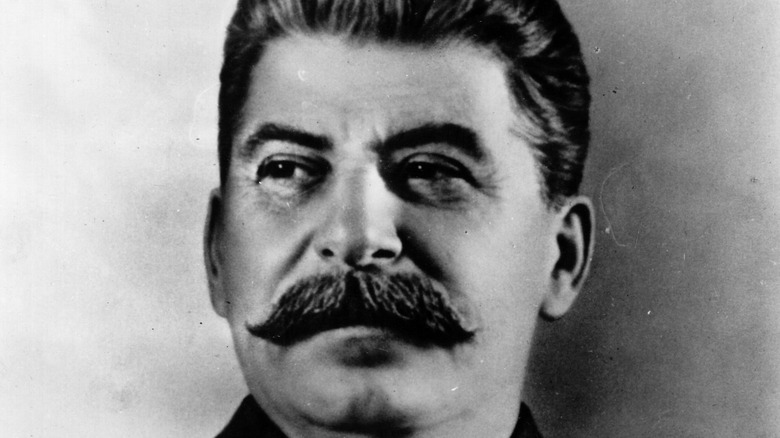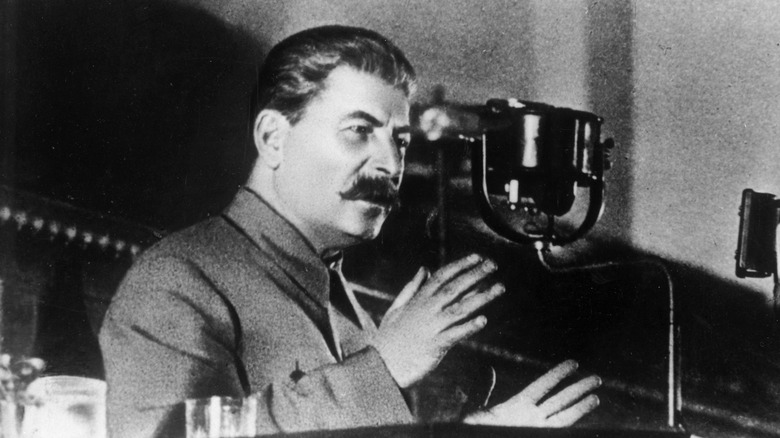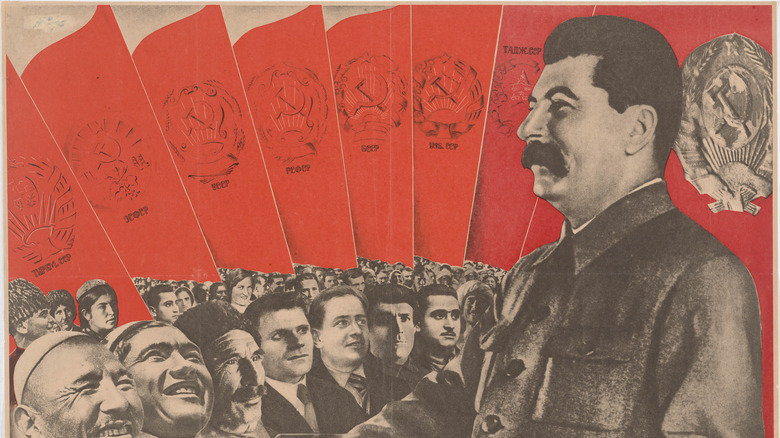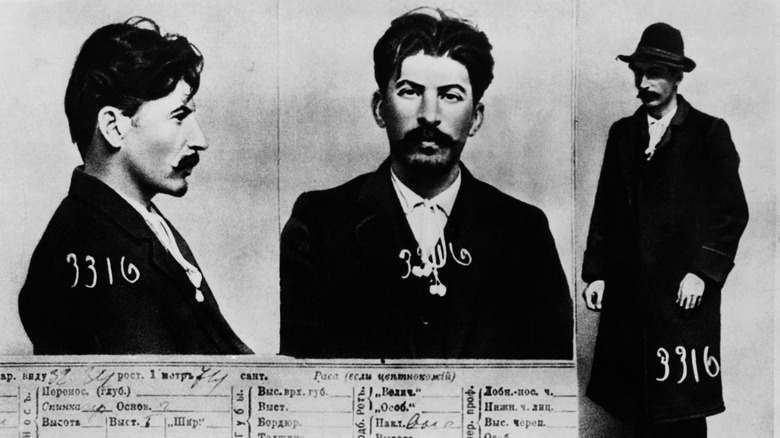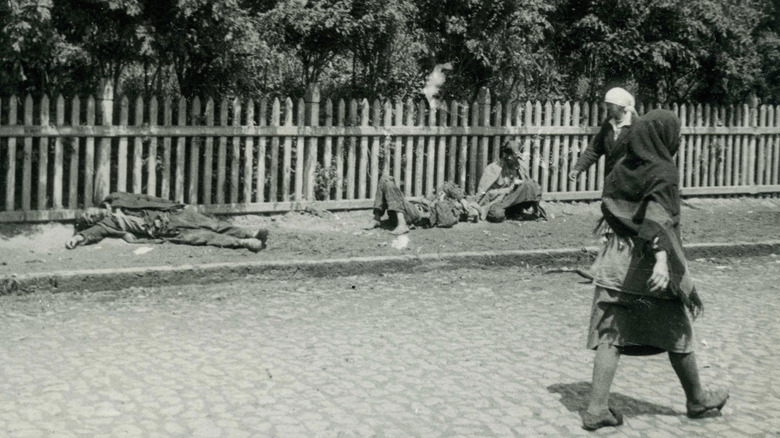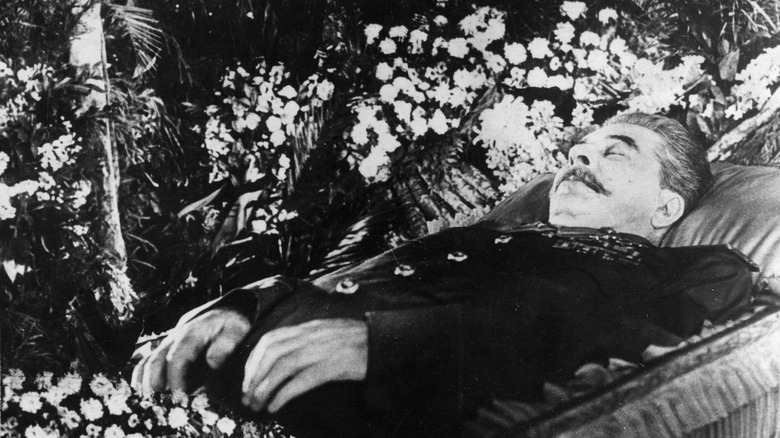How Joseph Stalin Was Even More Evil Than You Think
Joseph Stalin once claimed that "if only one man dies of hunger, that is a tragedy. If millions die, that's only [a] statistic," per The Oxford Reference. The horrifying quote probably gives one of the best insights into the creepy mind of one of the 20th century's most lethal dictators. As detailed by Biography, Stalin first began his rise to power in 1922, when he was appointed to the office of general secretary of the Communist Party — a position that was created following the demise of Tsarist rule. Though the job was not particularly powerful, it had control over all party appointments, and so Stalin began to build a loyal base for himself.
In 1924, Stalin moved to consolidate his power by purging members of the party he deemed to be a threat to his own personal ambition. This was often done through showy trials where evidence was fabricated or defendants were coerced into giving false confessions after being brutally tortured. Stalin's ascent was complete when he managed to banish Leon Trotsky — his main competitor for power — to Mexico. But even banishment wasn't enough, and Stalin's henchmen hunted Trotsky down and murdered him with an ice pick.
In total, historians estimate that Stalin was responsible for the deaths of around 20 million people, though many believe the total is much more. But horrifyingly enough, Stalin's death toll isn't the only evil thing about him. Here are some less-known facts about his life and actions.
Stalin allegedly wanted to create half-man, half-ape super warriors
It is not surprising that a man capable of mass genocide had a low opinion of mankind. However, a scientific study published by Cambridge University sheds light on just how far the brutal dictator was willing to go. The paper outlines how Stalin green-lit a program by biologist Ilia Ivanov that sought to breed humans with apes. According to The New Scientist, Ivanov even traveled to Guinea on his bizarre mission to cross-breed the human race. Once there, he managed to inseminate three chimps with human sperm, though he was left disappointed that none were able to conceive.
While there are no definite answers as to why Ivanov and Stalin embarked on such a freaky experiment, one persistent rumor is that Stalin had hoped to create a mutant super-warrior that could create an invincible army. "I want a new invincible human being, insensitive to pain, resistant and indifferent about the quality of food they eat," Stalin reportedly told Ivanov, as reported at the time by Moscow newspapers, per The Scotsman.
Though this claim has not been totally verified, it is true that Stalin was worried about the state of the red army after the enormous casualties suffered by the Russians in World War II. Perhaps a half-human generated group of soldiers was Stalin's sick idea of a solution. A second creepy hypothesis is that Stalin hoped to create a strong but docile working class with the mutant breed.
Stalin's doctor attempted to artificially inseminate African women with chimp sperm
After Ilia Ivanov's experiments with inseminating apes with human sperm failed, he went on to the next potential solution: inseminating women with chimp sperm. However, Ivanov ran into some issues. He knew that it was unlikely that anyone would volunteer to be a part of such an experiment, so he sought permission to trick African women into thinking they were receiving medical care.
Ivanov was about to perform the first procedure when he was fortunately barred from doing so by the General Governor of French Guinea, Paul Poiret. Moreover, word got out about Ivanov's experiments, prompting a widespread international outcry. Though the Soviets ended up denouncing Ivanov's behavior, their statement made it clear that their concern was that Ivanov "[undermined] the trust of Africans in European researchers and doctors and [made] problematic any further expeditions of Russian scientists to Africa" rather than any guilt regarding forced impregnation with a non-human species, per Scientific American.
The fact that the Soviet government displayed no shame in the horrific idea of cross-breeding allowed Ivanov to try the experiment again back in Russia. This time, he made clear that women who participated would be inseminated with chimpanzee sperm and urged loyal females to do so for "science." At least five women actually signed up, according to the New Scientist. Fortunately, the experiment never commenced as Ivanov was caught up in one of Stalin's many purges and sent to Kazakhstan. He died shortly afterward.
Stalin had at least one pedophilic affair
Stalin was a notorious womanizer, and it appears that he didn't let age stop him. When he was 35-years-old, he engaged in an affair with a girl named Lidia Pereprygina. She was an orphan who lived in an isolated hamlet near the Arctic Circle — and was only 13-years-old when she began having relations with Stalin.
According to the London Evening Standard, Stalin was in the remote area because he was exiled from his home in Georgia for his revolutionary activities. He was one of 67 people in the small town and almost immediately embarked on his affair with the young teen, even though she was below the age of consent. The fact that the two had embarked on such an inappropriate relationship did not endear him to the locals, and Lidia's brothers refused to let Stalin eat with them. As a result, the young teen was forced to cook meals for herself and Stalin alone.
Things got worse when Lidia got pregnant. Per the London Evening Standard, a policeman tasked to tail Stalin threatened "to instigate criminal proceedings for living together with an under-age girl. J.V. Stalin promised the policeman to marry Pereprygina when she came of age." Sadly, Lidia had a miscarriage before the baby was born. Nevertheless, she and Stalin continued their affair, and she got pregnant again. This time, Stalin did not stick around — he disappeared in the middle of the night, leaving the young teen to handle her pregnancy alone.
Stalin assigned the children of his victims new names so they couldn't honor their parents
As stated earlier, Stalin was responsible for millions of deaths. Arguably the infamous atrocity is Holodomor, a famine that gripped Ukraine from 1929 through the early 1930s. Though the Russian Federation continues to claim that the famine was just a natural disaster, many other governments and agencies — including Ukraine and the European Parliament — have stated that it was a man-made tragedy orchestrated to punish the Ukrainian people for protesting Stalin's collective farming. In total, around four million people — or 13 percent of the country's population — died from starvation, according to History. Sadly, so many people died, were imprisoned, or had fled that the government had to send Russian farmers to work the land.
Stalin also enacted a program known as the "Great Purge" between 1936 and 1938. According to Smithsonian Magazine, around 750,000 people were killed in secret, with millions more sent to the Gulag. Though the initial victims were mainly political rivals, the scope soon expanded to include peasants, minorities, artists, scientists, intellectuals, and writers. As if the death and exile of so many people wasn't tragedy enough, Stalin took his cruelty one step further by assigning the children of his victims new names, according to Fact Retriever. This move both stripped the children of their identities and made it nearly impossible for them to either track down or honor their parents when they grew older.
Stalin might have had a brain injury that made him sociopathic
One of the scariest parts about Stalin's crimes is that he may have been particularly cruel because of a brain injury. Stalin suffered from cerebral atherosclerosis, which is when arteries in the brain harden over time due to a build-up of plaque and fat. The illness not only contributed to the stroke that eventually killed Stalin but was also so advanced that one of the doctors who performed the autopsy believed that it affected Stalin's psyche.
"The major atherosclerosis in the brain, which we found at the autopsy, should raise the question of how much this illness — which had clearly been developing over a number of years — affected Stalin's health, his character, and his actions," Dr. Alexander Myasnikov wrote in his diaries, which were kept secret for years and only published in the past decade, per The Independent. "Stalin may have lost his sense of good and bad, healthy and dangerous, permissible and impermissible, friend and enemy. Character traits can become exaggerated so that a suspicious person becomes paranoid," he added.
Indeed, psychosis has long been linked with cerebral atherosclerosis, and Alzheimer's disease also has a strong correlation, according to JAMA Network. That said, whether Stalin's actions were the result of a diseased mind or his own sick nature, they were undoubtedly evil and will remain a tragedy in the annals of world history.
